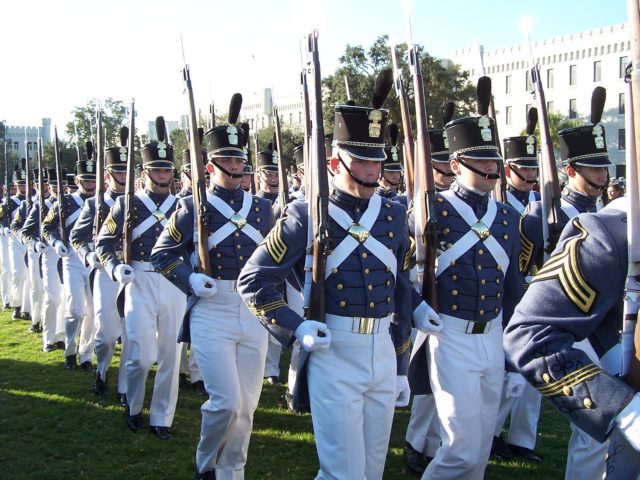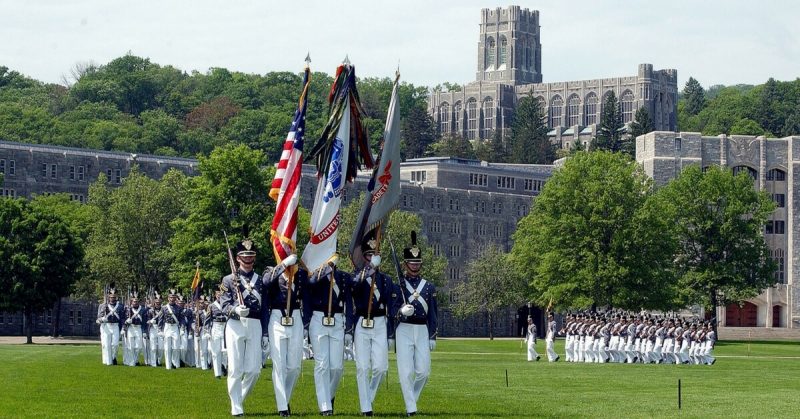The arrival of gunpowder led to many changes in warfare. One of the most important was the introduction of the military drill. A method of training men in new weapons and ways of fighting, it had many effects on armies and wars.
Lives Saved
Firing a musket was a dangerous business. Standing in formation while someone else fired one was even riskier. While troops acted individually but in a massed group, bobbing up and down as they loaded and fired their weapons, there was an uncomfortably high chance of them being hit by a shot from their own side.
Drill saved lives. It ensured troops knew how to load and fire their guns safely. By getting a whole unit to go through the same motions at the same time, it reduced the risk of friendly fire.
Mass Impact
An individual musket shot was not particularly accurate. Their battlefield power came from the impact of dozens or hundreds of guns all firing simultaneously. Drill enabled that to happen, maximizing psychological impact and increasing the chance of breaking the enemy’s nerve.
Faster Firing
The effectiveness of shooting was enhanced further by the speed at which drilled soldiers could fire. Repeated practice improved the complicated movements of preparing a muzzle-loading firearm. Habit made it easier to do it under pressure, such as when the enemy was firing back.
Discipline
One of the most noticeable effects of the drill was the improvement in discipline. The most fundamental aspect of soldiering – how to fight the enemy – was turned into a matter of obedience. There was no room for individual heroics, as there had been in earlier ages. Discipline was drummed into soldiers, increasing control over them.
Mass Movement
Aside from how to fire their guns quickly and more effectively, soldiers also learned another thing from drilling – how to move together.
It was a tremendous asset for commanders in the field. Once soldiers learned to march in line without getting in each others’ way, they could be trained to move quickly as a group. They could be turned and wheeled, shifted up and down the line, and moved into different formations. It was all done faster and more efficiently than in the days before drilling.
Large blocks of infantry could move faster around the battlefield.
Concentration of Troops
It also allowed commanders to achieve significant victories.
Knowing troops could and would move quickly on their command, they concentrated forces in ways that otherwise would have been impossible.
It was this that led to the great successes of men like the Duke of Marlborough. At the Battle of Ramillies in 1706, he moved troops quickly from one flank to another across the back of a convex line. The swift movement of his infantry, combined with deceptive maneuvering, allowed him to concentrate forces on his left, breaking the French lines.

The Need for Professional Armies
Drill made soldiering more complicated. To be useful on the battlefield, a soldier had to have trained in both firing and maneuvering exercises. He had to be in the habit of listening to and swiftly obeying commands. Ideally, he should be working with the same men day in and day out.
Any army not made up of such people would be at a severe disadvantage when the battle came.
Professional standing armies were needed. In the past, it had been common for troops to be pulled together when war was declared. Men were called up for service based on traditional obligations. They might practice shooting on a Sunday or march in a militia band once a month, but that was not enough to match regular drill.
Inflexibility
There were some downsides such as the loss of flexibility.
Drilled formation fighting was the best way to beat European armies in pitched battles and sieges. However, it encouraged an inflexible approach in both men and officers. When different circumstances arose, they were not ready to adapt.
An example was the British experience in North America. In 1755, General Braddock was beaten by French and Native American forces when he tried to use drill fighting in the American forests. Inflexibility cost many British lives and several defeats during the War of American Independence.
Holding Back Progress
Like any system based on strict conformity, drill held back progress. To work well, it needed things to stay as they were, or become better in very specific and limited ways.
One example of this was the slow adoption of rifles. Guns with rifled barrels have better range and accuracy, but rifled muskets were more complicated to use than unrifled ones. It made drilling with them harder. They were neglected for many years for speed and simplicity.
The lack of progress was reflected in tactics that barely changed from the second half of the 17th century to the late 19th.
Fitness
Changes in weapons eventually made drill-controlled fighting obsolete. Drilling itself retained some advantages and so is still used in training.
One of the most notable benefits is fitness. Repeated, intense exercise, paired with the pressure and encouragement of performing alongside others, makes drill a useful part of keeping soldiers in shape.
Unit Cohesion
As well as fitness and discipline, drill encourages unit cohesion. Sharing the activity and experience of doing something unrelated to civilian life bonds soldiers together. It helps to forge a sense of shared purpose and identity on which strong morale is built.
Drilling was created for an earlier era. Its original purpose has long been obsolete, but it remains a relevant part of army life.
Sources:
David Chandler and Ian Beckett (Eds) (1994), The Oxford History of the British Army
Richard Holmes, ed. (2001), The Oxford Companion to Military History
John Keegan and Richard Holmes (1985), Soldiers
John Keegan (1987), The Mask of Command
William Weir (2006), 50 Weapons that Changed Warfare
